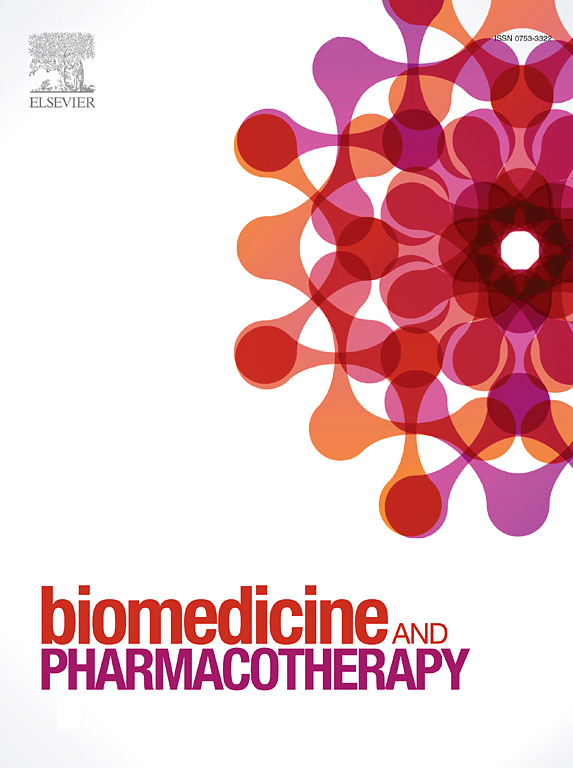Pre-treatment with notoginsenoside R1 from Panax notoginseng protects against high-altitude-induced pulmonary edema by inhibiting pyroptosis through the NLRP3/caspase-1/GSDMD pathway
IF 6.9
2区 医学
Q1 MEDICINE, RESEARCH & EXPERIMENTAL
引用次数: 0
Abstract
High-altitude pulmonary edema (HAPE) is a potentially fatal condition that occurs when exposed to high-altitude hypoxia environments. Currently, there is no effective treatment for HAPE, and available interventions focus on providing relief. Notoginsenoside R1 (NGR1), a major active constituent of Panax notoginseng (Burkill) F.H.Chen (sānqī), has demonstrated heart and lung-protective effects under hypobaric hypoxia. However, there is a lack of clarity regarding the precise mechanisms that underlie the protective effects of NGR1 against inflammation. In this study, a rat model of HAPE was developed to assess the effect of NGR1 on this pathology. High-altitude hypoxia corresponding to 6000 m altitude was simulated with a hypobaric chamber. We found that NGR1 dose-dependently alleviated pulmonary oxidative stress damage and inflammatory response, and prevented acid-base balance disruption. In addition, NGR1 restored the expression levels of hypoxia-inducible factor-1 alpha, vascular endothelial growth factor, and aquaporin protein-5, correlated with the development of pulmonary edema induced by hypobaric hypoxia. Furthermore, NGR1 pre-treatment remarkably mitigated NOD-like receptor family pyrin domain containing 3 (NLRP3) inflammasome-induced pyroptosis, and this effect was partially counteracted by the use of an NLRP3 agonist. Thus, NGR1 may exert a lung-protective effect against HAPE by ameliorating hypoxia-induced lung edema, oxidative damage, and inflammation through inhibition of the NLRP3/Caspase-1/ GSDMD signaling pathway.
通过NLRP3/caspase-1/GSDMD途径抑制高海拔诱发的肺水肿,用三七中的三七皂苷R1进行预处理可预防高海拔诱发的肺水肿
高海拔肺水肿(HAPE)是一种在高海拔缺氧环境下发生的可能致命的疾病。目前,还没有治疗高海拔肺水肿的有效方法,现有的干预措施主要是缓解病情。三七皂苷 R1(NGR1)是三七(Burkill)F.H.Chen(sānqī)的主要活性成分,在低压缺氧环境下具有保护心脏和肺部的作用。然而,NGR1 对炎症具有保护作用的确切机制尚不清楚。本研究建立了一个大鼠 HAPE 模型,以评估 NGR1 对这种病理学的影响。我们用低压舱模拟了相当于海拔 6000 米的高空缺氧。我们发现,NGR1 剂量依赖性地减轻了肺氧化应激损伤和炎症反应,并防止了酸碱平衡的破坏。此外,NGR1 还能恢复低氧诱导因子-1 α、血管内皮生长因子和水汽蛋白-5 的表达水平,而这三者与低压氧诱导的肺水肿发展相关。此外,NGR1 预处理可显著减轻 NOD 样受体家族含吡咯啉结构域 3(NLRP3)炎性细胞诱导的热蛋白沉积,而使用 NLRP3 激动剂可部分抵消这种效应。因此,NGR1 可通过抑制 NLRP3/Caspase-1/ GSDMD 信号通路,改善缺氧引起的肺水肿、氧化损伤和炎症,从而对 HAPE 发挥肺保护作用。
本文章由计算机程序翻译,如有差异,请以英文原文为准。
求助全文
约1分钟内获得全文
求助全文
来源期刊
CiteScore
11.90
自引率
2.70%
发文量
1621
审稿时长
48 days
期刊介绍:
Biomedicine & Pharmacotherapy stands as a multidisciplinary journal, presenting a spectrum of original research reports, reviews, and communications in the realms of clinical and basic medicine, as well as pharmacology. The journal spans various fields, including Cancer, Nutriceutics, Neurodegenerative, Cardiac, and Infectious Diseases.

 求助内容:
求助内容: 应助结果提醒方式:
应助结果提醒方式:


